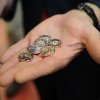Governor of the Bank of Latvia Ilmārs Rimšēvičs today started the minting equipment at the mint in Stuttgart, Germany, thereby launching the minting of Latvian euro coins.
The Latvian euro coins will feature the Latvian maiden from the interwar five-lats coin and the cents will sport the large and small version of Latvia’s coat of arms. The author of the graphic design for the 1- and 2-euro coins is Guntars Sietiņš and the author of the euro cent design is Laimonis Šēnbergs. People’s Competition of Ideas for the design of Latvian euro coins took place already in 2004 and the proposal of Ilze Kalniņa, resident of Jēkabpils, has now been put to use, albeit in a contracted form. Much work by artists and minting specialists has gone into preparing the coins, so that Latvia could once again take pride in well-designed money that will be legal tender in all euro area countries.
The event at Staatliche Münzen Baden-Württemberg was attended by Ingo Rust, state secretary of the Finance Ministry of Baden-Württemberg, management of the mint as well as representatives of the producers of prototypes of Latvian euro coins. The largest television channels of Latvia were also invited to record the launch as well as representatives of several German media.
Addressing the people present, Mr. Rimšēvičs emphasized the importance of the moment to Latvia. The path to euro introduction was long and took ten years since Latvia joined the European Union. The Governor of the Bank of Latvia praised the collaboration with the Baden-Württemberg State Mint as very successful, which is good reason to be optimistic about the future.
The director of the mint Peter Huber said that the Bank of Latvia is a very demanding client, but the Baden-Württemberg mint has enough experience and professional expertise to be able to handle the most complicated orders. Previously, the mint has collaborated with the Bank of Latvia in minting both special-design one-lats coins and circulation coins.
Overall, 12 billion euro coins have been struck in the two mints of Baden-Württemberg. 20 money presses are designed for striking circulation coins and eight for collector’s coins and medals.
Jānis Blūms, head of the Cash and Money Circulation Department of the Bank of Latvia said that to ensure that all the lats coins in circulation can be exchanged and there is a reserve for euro circulation in 2013-2014, 400 million euro coins of different denominations will be needed (expressed in units of weight, it would amount to about 1600 tons).
The Latvian euro coins necessary for the changeover and the first year of circulation will be struck in two production units of the aforementioned mint, in Stuttgart and Karlsruhe. This mint, chosen through a competition, has previously struck several lats circulation coins, for example, both one-lats coins of special design of 2012, featuring the hedgehog and Christmas bells, as well as about 40% of all German euro coins.

The People’s Competition of Ideas for the design of Latvian euro coins took place in 2004. The panel of judges decided that the proposal of Ilze Kalniņa, who resides in Jēkabpils, was the best. She proposed to have the euro coins feature the portrait of a Latvian folk maiden, the Freedom Monument and the coat of arms of Latvia. The signs that represent a symbolized essence of Latvia: the love of its homeland of our nation; the longing and fight for freedom, and pride in the land and its people. In a contracted form, this proposal is retained in the approved samples: the euro coins will feature the pride of our money design, the maiden from the interwar five-lats piece and the cents will bear the image of the large and small version of Latvia’s coat of arms.
The European side of euro coins – the one with the denomination – is the same in all euro area countries, whereas the national side differs from country to country. The coins of all countries are legal tender throughout the euro area. Euro and cent coins of eight various denominations – 1 and 2 euro and 1, 2, 5, 10, 20 and 50 cents – are circulated in the euro area. The denominations are thus the same as for the lats and santim coins.
So that the residents of Latvia would have a chance to acquaint themselves with the new money in a timely manner, the Bank of Latvia will organize informative events; moreover, sample sets of euro coins will be available as of 10 December 2013. They will contain euro coins of all denominations and will cost 10 lats or 14 euro and 23 cents. The sets will be available for purchase at commercial banks, 302 branches of Latvian Postal Service and the cash windows of the Bank of Latvia in Riga, Liepāja and Daugavpils.
Collector’s coins will be issued every year in approximately the same amount as before. Their circulation will depend on local and international demand. These coins are legal tender only in the country of issue. Their denomination has to differ from that of circulation coins (e.g., 5 or 10 euro).
Every year, each member state may also issue two special 2-euro coins commemorating some event of state, European or global significance. An additional 2-euro coin may be issued within the framework of some common project of European Union countries.
The lats collector’s coins that will not have been sold out will continue to be sold by the Bank of Latvia as collector’s items that do not have the status of legal tender.
Euro banknotes are the same throughout the euro area (for more information, please refer to the European Central Bank’s webpage– http://www.new-euro-banknotes.eu). No banknotes will be printed especially for Latvia: they will be borrowed from some central bank in the Eurosystem, and in subsequent years they will be returned when banknotes are printed in accordance with the schedule devised by the European Central Bank. Later costs of banknote production and delivery are estimated at 7.1 million lats.
Joining the euro area, the Bank of Latvia will ensure the changeover to the euro as legal tender both in cash and non-cash currency, so that money circulation in the country can continue without disruption. The most visible and, in terms of costs, most important part of the process is the banknotes and coins: minting and delivery of Latvian euro coins as well as the delivery of banknotes to the Bank of Latvia and subsequent supplying of banks with cash.
In November and December 2013, the Bank of Latvia will deliver euro banknotes and coins to its direct clients, i.e. commercial banks. As of 10 December, banks will be ready to begin supplying euro cash to their clients, businesses and shops, and to sell the start-up set of euro coins to the public. It should be kept in mind that until 1 January 2014 euro coins with Latvian symbols and the euro banknotes supplied before the changeover date will not yet be legal tender. It should also be kept in mind that one lats will be exchanged for 1.42 euro (this is the figure obtained dividing one lats by the exchange rate set by the Bank of Latvia at 0.702804).
During the changeover period beginning 1 January 2014, cash currency will be exchanged at Latvia’s commercial banks (for 6 months), branches of Latvian Postal Service that are located in less populated areas without bank branches or ATMs (for 3 months), at the cash windows of the Bank of Latvia in Riga, Liepāja and Daugavpils (for an unlimited time).
As of 1 January 2014, the accumulated cash coins (piggy-bank contents) will be exchanged, free of charge and in unlimited amounts, at commercial banks. If someone has a need to exchange coins for (lats) banknotes earlier, it will be bpossible at the Bank of Latvia as of 1 October 2013 – in unlimited amounts and without paying commission.
The most intense changeover period for many participants in the circulation of cash will be the period of simultaneous circulation of the lats and the euro: 1-14 January 2014. The owners of lats will then be able to pay either in lats or euro, but they will receive the change in euro. There are some exceptions, however, for instance, public buses where the change will also be given in lats.



